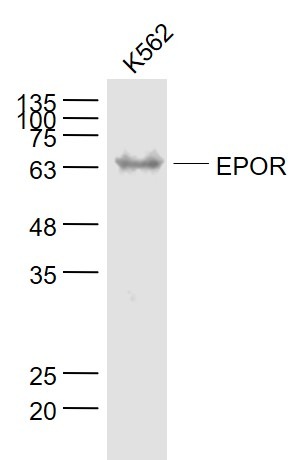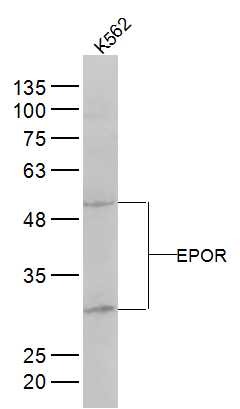Shopping Cart
Remove All Your shopping cart is currently empty
Your shopping cart is currently empty
Anti-EPOR Polyclonal Antibody is a Rabbit antibody targeting EPOR. Anti-EPOR Polyclonal Antibody can be used in IF,IHC-Fr,WB.
| Pack Size | Price | USA Warehouse | Global Warehouse | Quantity |
|---|---|---|---|---|
| 50 μL | $220 | 7-10 days | 7-10 days | |
| 100 μL | $374 | 7-10 days | 7-10 days | |
| 200 μL | $527 | 7-10 days | 7-10 days |
| Description | Anti-EPOR Polyclonal Antibody is a Rabbit antibody targeting EPOR. Anti-EPOR Polyclonal Antibody can be used in IF,IHC-Fr,WB. |
| Synonyms | erythropoietin receptor, EPO-R |
| Ig Type | IgG |
| Reactivity | Human,Rat (predicted:Mouse,Dog,Cow,Horse) |
| Verified Activity | 1. Sample: K562 (Human) Cell Lysate at 30 μg Primary: Anti-EPOR (TMAB-00628) at 1/1000 dilution Secondary: IRDye800CW Goat Anti-Rabbit IgG at 1/20000 dilution Predicted band size: 56 kDa Observed band size: 64 kDa 2. Sample: K562 (Human) Cell Lysate at 30 μg Primary: Anti-EPOR (TMAB-00628) at 1/300 dilution Secondary: IRDye800CW Goat Anti-Rabbit IgG at 1/20000 dilution Predicted band size: 56 kDa Observed band size: 30/52 kDa   |
| Application | |
| Recommended Dose | WB: 1:500-2000; IHC-Fr: 1:100-500; IF: 1:100-500 |
| Antibody Type | Polyclonal |
| Host Species | Rabbit |
| Subcellular Localization | Cell membrane; Single-pass type I membrane protein. Isoform EPOR-S: Secreted. Note=Secreted and located to the cell surface. |
| Tissue Specificity | Erythroid cells and erythroid progenitor cells. Isoform EPOR-F is the most abundant form in EPO-dependent erythroleukemia cells and in late-stage erythroid progenitors. Isoform EPOR-S and isoform EPOR-T are the predominant forms in bone marrow. Isoform EP |
| Construction | Polyclonal Antibody |
| Purification | Protein A purified |
| Appearance | Liquid |
| Formulation | 0.01M TBS (pH7.4) with 1% BSA, 0.02% Proclin300 and 50% Glycerol. |
| Concentration | 1 mg/mL |
| Research Background | The erythropoietin receptor (EPOR) is a member of the cytokine receptor family. There are several isoforms including: EPOR-F (full length), EPOR-S (soluble form), and EPOR-T (truncated form). Upon erythropoietin (EPO) binding, the EPOR activates Jak2 tyrosine kinase which activates different intracellular pathways including: Ras/MAP kinase, phosphatidylinositol 3-kinase and STAT transcription factors. The stimulated EPOR appears to have a role in erythroid cell survival. Defects in the EPOR may produce erythroleukemia and familial erythrocytosis. A functional EPOR is found in the cardiovascular system, including endothelial cells and cardiomyocytes, and data suggest that the EPO/EPO receptor system plays an important role in cardiac function. In animal studies, treatment with EPO during ischemia/reperfusion in the heart has been shown to limit the infarct size and the extent of apoptosis. |
| Immunogen | KLH conjugated synthetic peptide: human EPOR |
| Antigen Species | Human |
| Gene Name | EPOR |
| Gene ID | |
| Protein Name | Erythropoietin receptor |
| Uniprot ID | |
| Biology Area | Angiogenic Factors,Endothelial Cell Markers,Ischemia / Reperfusion,Apoptosis,Hypertrophy,Receptors,Small G Proteins,Surface Molecules |
| Function | Receptor for erythropoietin. Mediates erythropoietin-induced erythroblast proliferation and differentiation. Upon EPO stimulation, EPOR dimerizes triggering the JAK2/STAT5 signaling cascade. In some cell types, can also activate STAT1 and STAT3. May also activate the LYN tyrosine kinase. Isoform EPOR-T acts as a dominant-negative receptor of EPOR-mediated signaling. |
| Molecular Weight | Theoretical: 56 kDa. |
| Stability & Storage | Store at -20°C or -80°C for 12 months. Avoid repeated freeze-thaw cycles. |
| Transport | Shipping with blue ice. |
| Size | Quantity | Unit Price | Amount | Operation |
|---|

Copyright © 2015-2026 TargetMol Chemicals Inc. All Rights Reserved.